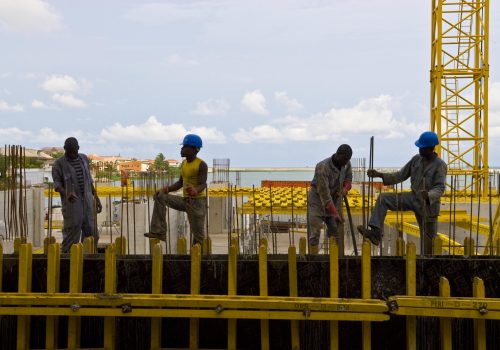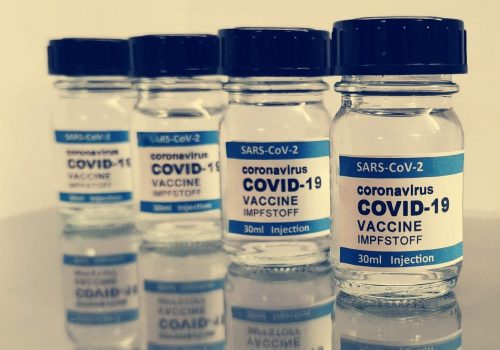Africa’s real strategic import for the green economy
Among its efforts to address climate change, the Biden administration has laid out an ambitious agenda for a clean energy revolution that aspires to have the United States achieve a carbon pollution-free power sector by 2035 and a zero-net economy by 2050. Getting anywhere close to these goals will require not only the “talent, grit, and innovation of American workers”—and businesses—but also significant quantities of raw materials. And here the African continent, especially the central region around the Great Lakes, has an important role to play, albeit in some ways often overlooked in discussions, but no less strategic.
Getting greener will require a lot more of everything from solar panels to wind turbines to electric vehicles to large-scale batteries to hand-held devices. This, in turn, will drive demand for various minerals and metals, both commonly well-known and not-so-familiar, on which the clean-energy technologies depend.
African countries are already a major source for some of these elements. For example, cobalt is a key component in rechargeable batteries. Roughly half of the 7.1 million metric tons of total global reserves of cobalt are found in the Democratic Republic of the Congo (DRC) which, moreover, accounts for 70 percent of overall production of the metal, according to the most recent statistics.
In other cases, certain African countries are key to a secure supply chain. Take the case of neodymium, a silvery rare-earth metal that plays an outsized role in renewable energy since there is currently no ready substitute for it in the manufacture of so-called permanent magnets used in both generators (where they convert mechanical energy into electricity) and electric vehicles (where they do the reverse, converting electricity into mechanical energy)—and this is in addition to its longstanding uses in a host of applications ranging from credit cards to speakers to medical equipment. Some 80 percent of the world’s neodymium is currently produced by China, a fact that suggests that the supply of this critical metal will come up in at least two of the reviews mandated by President Biden’s executive order on America’s supply chains, the study of high-capacity battery supplies led by the Secretary of Energy and the review of critical minerals led by the Secretary of Defense. While the reviews are currently underway, the possible alternative sources are already known: the Gakara Mine in Burundi operated by London-listed Rainbow Rare Earths and the Songwe Hill Mine in Malawi operated by Canada’s Mkango Resources. Of course, getting the ore is only part of the challenge; until alternative avenues for offtake are created, these producers will still have to turn to China for processing.
But seemingly esoteric minerals, whether technically rare-earth elements or not, are not the only material inputs needed for the transition to clean energy. A greener economy will also require even greater volumes of some metals that humankind has been exploiting for millennia.
The switch to cleaner, electrically-powered vehicles, for example, will require copper—lots of it. A conventional automobile operating with an internal-combustion engine contains on average about 48 pounds of copper, a hybrid electrical vehicle (HEV) about 88 pounds, and a battery electric vehicle (BEV) about 183 pounds, according to the Copper Development Association, an industry-supported nonprofit research and educational group. HEV and BEV public transportation require upwards of 1,000 pounds of the ductile native metal. Renewable energy infrastructure also requires large amounts of copper. According to the National Mining Association, 4.7 tons of copper go into each typical wind turbine. No wonder that, as enthusiasm for electric vehicles gained momentum, copper prices doubled over the last year to over $9,000 per metric ton in February, the highest level in almost ten years and pretty close to the all-time record price set in 2011, staying ever since at that level. The biggest trader of the metal reportedly expects the price to surge even further to $15,000 a ton this decade “as demand for global decarbonization produces a deep market deficit.”
While increased demand accounts for part of the commodity’s price, there is also a supply-side factor as many existing mines are in the declining phases of their life cycles. In fact, a peer-reviewed study a few years ago suggested that without new reserves being tapped, global copper production may be nearing peak just when demand is set to spike. Thus, projects under development are perhaps even more important than existing production. Moreover, with some potential major producers, like Alaska’s Pebble Mine, facing uncertain futures due to environmental concerns and regulatory issues, the pipeline for new sources is critical. Of the top ten projects currently under development, the biggest by far is Canadian mining company Ivanhoe’s Kamoa-Kakula project in the DRC, which contains 38 million tons of copper, more than twice the amount of the second-placed Pebble Mine—if the latter ever produces.
There is also increased demand anticipated for iron, a metal humankind has worked with for since the Middle Bronze Age. The same wind turbine that contains 4.7 tons of copper, requires 335 tons of steel which, of course, is an iron alloy. While three of the largest iron mines in the world are located in Brazil and, unsurprisingly, operated by the country’s flagship Vale, the Zanaga Mine in the Republic of the Congo is not far behind in scale. And the literal mother lode is in Guinea, where the world’s largest—and, by many estimates, the highest-quality—untapped iron ore deposits are to be found in the hills of the country’s east at Simandou and in nearby blocks. Bringing online this resource will not only transform the global supply chain for the critical ingredient in steel, but it carries the promise of dramatically jumpstarting the development of Guinea and its neighbor Liberia, respectively the 178th and 175th placed on the most recent UNDP Human Development Index of 189 countries and territories (exporting the ore through the nearby Liberian port of Buchanan makes far more economic sense than hauling it overland some 400 miles to the Guinean capital of Conakry on a not-yet-built railroad).
With government, industry (witness GM’s announcement of plans to become carbon neutral in its products and operations by 2040), and individuals widely embracing the various aspects of the green economy from major infrastructure to manufacturing to consumer products, the African continent will play an increasingly strategic role by providing critical material inputs to the supply chain. This reality will necessitate both a greater focus on Africa on the part of governments and companies as well as a better coordination between the public and private sectors, but it also provides African countries with an unprecedented opportunity to leverage this new attention to the benefit of their citizens and economies.
Ambassador J. Peter Pham, a distinguished fellow at the Atlantic Council’s Africa Center, was the first-ever US Special Envoy for the Sahel Region. Previously he served as US Special Envoy for the Great Lakes Region of Africa. Prior to serving in government, he was Atlantic Council vice president for research and regional initiatives and director of the Africa Center. Follow him on Twitter @DrJPPham.
Further reading
Image: Photo: REUTERS/Cooper Inveen


